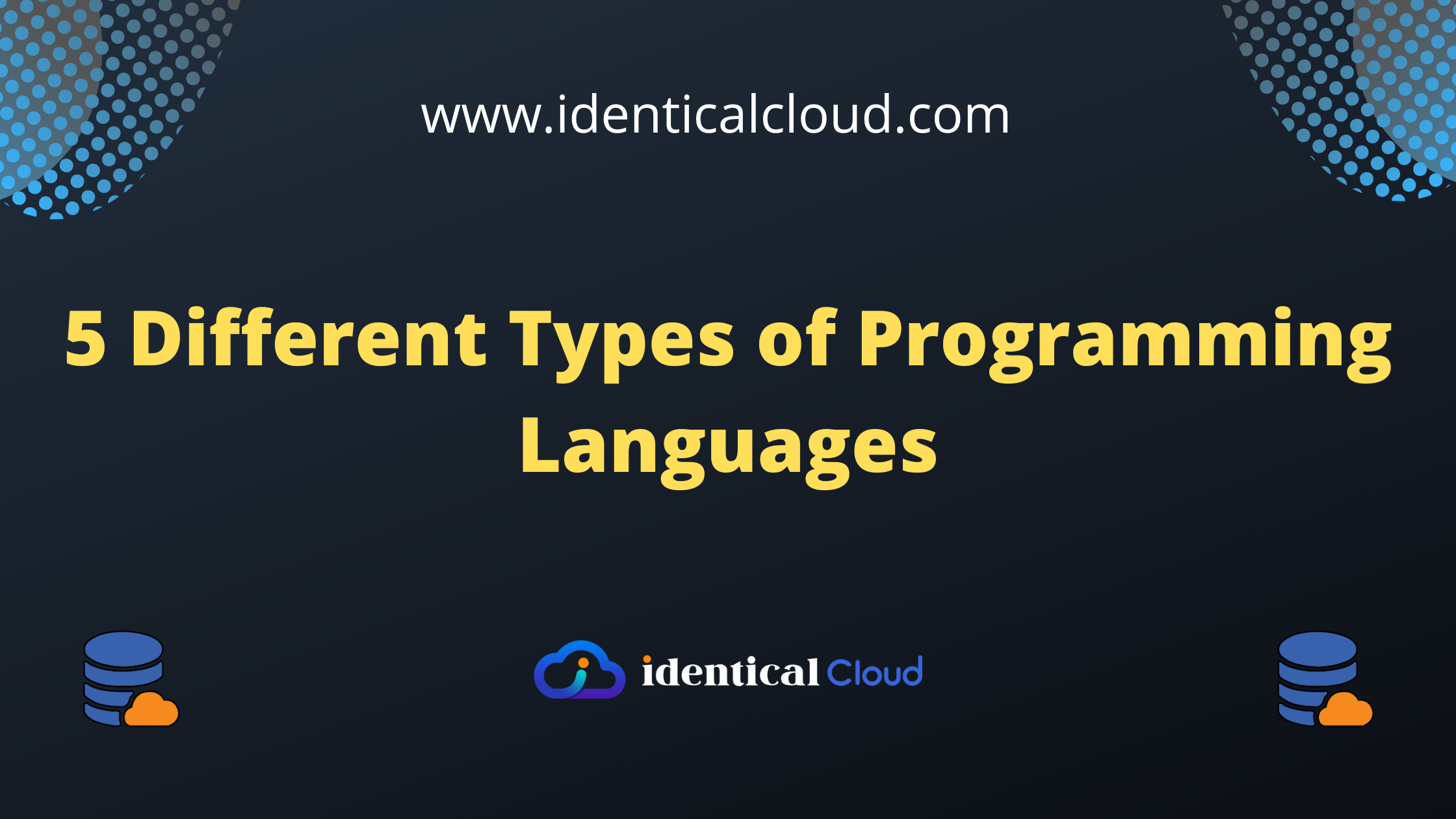
5 Different Types of Programming Languages
5 Different Types of Programming Languages
Programming languages are the building blocks of software. There are many different types of programming languages, each with its own strengths and weaknesses. This blog post explores 5 different types of programming languages, including procedural, object-oriented, functional, scripting, and markup languages. It also provides examples of popular languages in each category.
Procedural Programming Languages
Procedural programming languages, often considered the “traditional” type, are based on a linear sequence of instructions that the computer follows to execute a task. These languages use procedures or routines that consist of a series of statements to manipulate data. C, Pascal, and Fortran are some of the popular procedural languages.
One of the primary advantages of procedural languages lies in their simplicity and ease of understanding, making them suitable for beginners. They are often employed in system-level programming, scientific computing, and embedded systems where precise control over hardware resources is crucial.
Features of Procedural Programming Languages
Procedural programming languages are characterized by the following features:
- Procedures: Procedural programming languages allow programmers to define procedures, which are sequences of instructions that are executed together to perform a specific task.
- Data types: Procedural programming languages have a fixed set of data types, such as integers, floating-point numbers, and strings.
- Control flow: Procedural programming languages allow programmers to control the flow of execution of their programs using statements such as if, while, and for.
- Functions: Procedural programming languages allow programmers to define functions, which are similar to procedures but can also return a value.
Advantages of Procedural Programming Languages
Procedural programming languages have a number of advantages, including:
- Simplicity: Procedural programming languages are relatively simple to learn and understand.
- Efficiency: Procedural programming languages can be optimized for efficiency, making them well-suited for tasks that require a lot of computational power.
- Portability: Procedural programming languages are relatively portable, meaning that they can be used on different platforms and devices.
Disadvantages of Procedural Programming Languages
Procedural programming languages also have a number of disadvantages, including:
- Lack of abstraction: Procedural programming languages do not provide a lot of abstraction, which can make it difficult to write modular and reusable code.
- Complexity: Procedural programming languages can become complex as the size of the program increases.
- Error-prone: Procedural programming languages can be error-prone, as it can be difficult to track the flow of execution of a program.
Object-Oriented Programming Languages
Object-oriented programming (OOP) is a programming paradigm based on the concept of objects. An object is a self-contained unit of data and code that represents an entity in the real world. Objects can interact with each other by sending messages.
OOP languages are some of the most popular programming languages in use today. They are used to create a wide variety of software applications, including operating systems, web applications, and video games.
Features of Object-Oriented Programming Languages
Object-oriented programming languages are characterized by the following features:
- Objects: Object-oriented programming languages allow programmers to define objects, which are self-contained units of data and code that represent an entity in the real world.
- Classes: Classes are blueprints for objects. They define the data and code that an object will have.
- Inheritance: Inheritance is the ability of one object to inherit the properties of another object. This allows programmers to reuse code and create more complex objects.
- Polymorphism: Polymorphism is the ability of an object to take on different forms. This allows programmers to create objects that can be used in different ways.
- Encapsulation: Encapsulation is the hiding of data and code from other objects. This allows programmers to protect data and code from unauthorized access.
Advantages of Object-Oriented Programming Languages
Object-oriented programming languages have a number of advantages, including:
- Abstraction: Object-oriented programming languages allow programmers to abstract away the details of how an object works. This makes it easier to understand and use objects.
- Modularity: Object-oriented programming languages allow programmers to break down a program into smaller, more manageable modules. This makes it easier to maintain and extend a program.
- Reusability: Object-oriented programming languages allow programmers to reuse code by creating classes and objects. This can save time and effort when developing new software.
- Extensibility: Object-oriented programming languages allow programmers to extend existing classes and objects. This can be used to add new features to a program or to adapt a program to new requirements.
Disadvantages of Object-Oriented Programming Languages
Object-oriented programming languages also have a number of disadvantages, including:
- Complexity: Object-oriented programming languages can be complex, especially for beginners.
- Performance: Object-oriented programming languages can be slower than procedural programming languages, especially for small programs.
- Overhead: Object-oriented programming languages can add overhead to a program, especially for small programs.
Functional Programming Languages
Functional programming (FP) is a programming paradigm that treats computation as the evaluation of mathematical functions and avoids changing-state and mutable data. It emphasizes the application of functions, in contrast to the imperative programming style, which emphasizes changes in state.
FP languages are some of the most popular programming languages in use today. They are used to create a wide variety of software applications, including operating systems, web applications, and scientific computing applications.
Features of Functional Programming Languages
Functional programming languages are characterized by the following features:
- Functions: Functional programming languages treat computation as the evaluation of mathematical functions. This means that functions are the basic building blocks of programs.
- Immutability: Functional programming languages avoid changing-state and mutable data. This makes programs easier to understand and reason about.
- Recursion: Functional programming languages make extensive use of recursion. This allows programmers to write concise and elegant code.
- Lazy evaluation: Functional programming languages often use lazy evaluation. This means that expressions are only evaluated when they are needed. This can improve performance and memory usage.
Advantages of Functional Programming Languages
Functional programming languages have a number of advantages, including:
- Expressiveness: Functional programming languages are often more expressive than other programming languages. This means that they can be used to write more concise and elegant code.
- Efficiency: Functional programming languages can be very efficient. This is because they avoid changing-state and mutable data.
- Fault tolerance: Functional programming languages are often more fault-tolerant than other programming languages. This is because they do not rely on side effects.
- Testability: Functional programming languages are often easier to test than other programming languages. This is because they do not rely on side effects.
Disadvantages of Functional Programming Languages
Functional programming languages also have a number of disadvantages, including:
- Complexity: Functional programming languages can be complex, especially for beginners.
- Lack of support: Functional programming languages are not as widely supported as other programming languages. This can make it difficult to find libraries and tools for functional programming languages.
- Performance: Functional programming languages can be slower than other programming languages for some tasks.
Scripting Languages
Scripting languages, in contrast to compiled languages, are often interpreted and executed line by line. They are commonly used for automating tasks, web development, and prototyping. Scripting languages facilitate rapid development and debugging, making them popular among developers for quick iterations. JavaScript, Python, and Ruby are widely-used scripting languages.
The versatility and ease of use of scripting languages have contributed to their prevalence in web development, where they power the interactivity and dynamic content of modern websites.
Features of Scripting Languages
Scripting languages are characterized by the following features:
- Interpreted: Scripting languages are interpreted, not compiled. This means that they are not converted into machine code before they are executed. This makes them slower than compiled languages, but it also makes them easier to develop and debug.
- High-level: Scripting languages are high-level languages. This means that they are closer to human language than low-level languages, such as C or assembly language. This makes them easier to learn and use.
- Extensible: Scripting languages are often extensible. This means that they can be extended with new features or libraries. This makes them very versatile and adaptable to new tasks.
Advantages of Scripting Languages
Scripting languages have a number of advantages, including:
- Quick and easy: Scripting languages are quick and easy to use. This makes them ideal for tasks that require quick and easy automation.
- Extensible: Scripting languages are extensible. This makes them very versatile and adaptable to new tasks.
- Portable: Scripting languages are portable. This means that they can be used on different platforms and devices.
Disadvantages of Scripting Languages
Scripting languages also have a number of disadvantages, including:
- Performance: Scripting languages can be slower than compiled languages.
- Security: Scripting languages can be less secure than compiled languages.
- Complexity: Scripting languages can be complex, especially for complex tasks.
Markup Languages
Markup languages are used to create and format documents, web pages, and other types of content. Markup languages are not programming languages in the traditional sense, but they are essential for creating many types of digital content. Some popular markup languages include HTML, XML, and CSS.
Markup languages are good for tasks that require a lot of formatting. They are also good for tasks that need to be portable, as they can be used on different devices and platforms.
Features of Markup languages
Markup languages are characterized by the following features:
- Tags: Markup languages use tags to describe the structure and content of a document. Tags are special words or symbols that are used to identify different parts of a document.
- Attributes: Markup languages can also use attributes to provide additional information about a tag. Attributes are key-value pairs that are attached to a tag.
- Comments: Markup languages can also use comments to provide explanations or notes about a document. Comments are not interpreted by the computer, but they can be read by humans.
Examples of Markup Languages
Some of the most popular markup languages include:
- HTML: HTML (HyperText Markup Language) is the markup language used to create web pages.
- XML: XML (eXtensible Markup Language) is a markup language that is used to create structured documents.
- CSS: CSS (Cascading Style Sheets) is a language that is used to style HTML documents.
- SGML: SGML (Standard Generalized Markup Language) is a markup language that is used to create structured documents.
Advantages of Markup Languages
Markup languages have a number of advantages, including:
- Structure: Markup languages can be used to structure documents in a way that is easy to understand for both humans and computers.
- Portability: Markup languages are portable, meaning that they can be used on different platforms and devices.
- Extensibility: Markup languages can be extended with new tags and attributes. This makes them very versatile and adaptable to new tasks.
Disadvantages of Markup Languages
Markup languages also have a number of disadvantages, including:
- Complexity: Markup languages can be complex, especially for complex documents.
- Not programming languages: Markup languages are not programming languages, meaning that they cannot be used to create executable code.
Here is a table summarizing the different types of programming languages:
| Type of Programming Language | Description | Examples |
|---|---|---|
| Procedural programming languages | Designed to execute instructions in a specific order | C, Pascal, Fortran |
| Object-oriented programming languages | Designed to create objects containing data and functionality | Java, Python, Ruby |
| Functional programming languages | Designed to use mathematical functions to perform tasks | Haskell, Lisp, ML |
| Scripting languages | Designed to automate tasks and interact with other programs | JavaScript, PHP, Perl |
| Markup languages | Used to create and format documents, web pages, and other types of content | HTML, XML, CSS |
There are many different types of programming languages, each with its own strengths and weaknesses. The best type of language for a particular task will depend on the specific requirements of that task.
If you are a beginner, it is a good idea to start with a procedural programming language like C or Pascal. These languages are relatively simple to learn and can be used to build a wide variety of applications.
Once you have a good understanding of procedural programming, you can then move on to other types of programming languages, such as object-oriented programming languages, functional programming languages, or scripting languages.
The most important thing is to choose a language that you are interested in and that you are motivated to learn. With a little effort, you will be able to master any programming language that you choose.
I hope this blog post has helped you to learn more about the different types of programming languages. If you have any questions, please feel free to leave a comment below.








